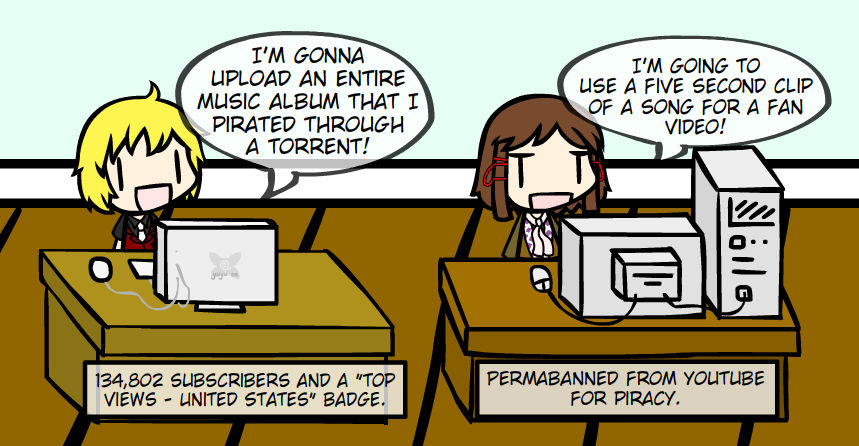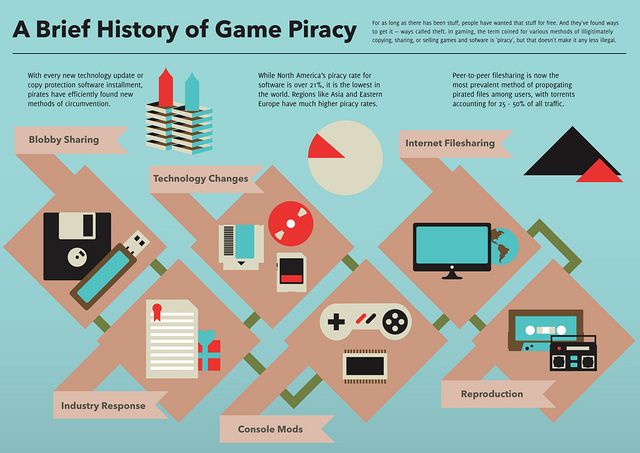Welcome to the world of YouTube, where content creators thrive and share their passion with the world! However, navigating YouTube's content policies can be a bit like crossing a minefield, especially when it comes to topics like video game piracy. Understanding these policies is essential for creators who want to avoid copyright strikes and keep their channels safe. In this post, we'll dive into
The Definition of Video Game Piracy

So, what exactly is video game piracy? In simple terms, it refers to the unauthorized copying, distribution, or use of video games. This can include:
- Downloading a game without purchasing it.
- Sharing game files with others.
- Using emulators to play games without owning the original copy.
- Streaming or uploading gameplay footage from copyrighted games without permission.
Video game piracy not only affects game developers and publishers, but it also poses significant risks for content creators on platforms like YouTube. When you upload a video featuring pirated content, you can face legal consequences, including copyright strikes against your channel. These strikes can lead to demonetization, video removal, or even channel termination.
It's important to differentiate between legitimate content and piracy. For instance, creating gameplay videos, reviews, or tutorials using fair use principles is generally acceptable, provided you add substantial commentary, critique, or educational value. But if you're simply showcasing a game without adding your unique touch, you may be treading into dangerous territory.
Moreover, many game publishers have specific policies regarding how their games can be used in videos. Some encourage content creation, while others may have strict limitations. Always check the publisher's guidelines before uploading to avoid any potential issues.
In summary, video game piracy is a broad term that includes any unauthorized use of games, and content creators must tread carefully. Understanding what constitutes piracy and adhering to fair use principles can help you create engaging content while staying on the right side of the law. Remember, the gaming community thrives on creativity and respect for the hard work that goes into game development, so let’s keep it that way!
Also Read This: What Is the Most Viewed Livestream on YouTube? A Look at Record-Breaking Events
YouTube's Stance on Copyrighted Content

YouTube takes copyright infringement seriously, especially when it comes to video game content. If you’re a creator, understanding this stance can help you navigate the platform more effectively. In essence, YouTube adheres to a strict policy that prohibits the uploading of copyrighted material without permission. This includes gameplay footage, music, and other media that you don’t own.
When you upload a video, the platform uses a system called Content ID. This technology scans your content against a vast database of copyrighted materials. If it detects something that matches, you could face various consequences, like having your video removed, your monetization disabled, or even receiving a copyright strike. These strikes can accumulate quickly; three strikes lead to channel termination, which is a creator’s worst nightmare!
However, it’s not all doom and gloom! YouTube does provide some leeway for creators. For instance, many game developers and publishers allow creators to use their footage, often stipulating some basic guidelines to follow. Always check the specific game's policy. Titles like Fortnite and Minecraft have embraced community content, offering clear permissions that empower creators, while others may be stricter. This is a great opportunity for creators to engage with the community and showcase their love for gaming!
In summary, be mindful of copyright when creating content on YouTube. Research the games you want to feature and consult their policies. It’s wise to err on the side of caution—better safe than sorry!
Also Read This: How to Sync YouTube TV Across Devices for Consistent Viewing
Understanding Fair Use in Video Game Content
Fair use is a term that often gets thrown around, especially in discussions about video content. But what does it really mean, particularly in the realm of video games? Fair use allows for limited use of copyrighted material without needing permission from the copyright holder. However, it’s a bit of a gray area and can be tricky to navigate.
To help clarify, here are the four factors that determine whether your use qualifies as fair use:
- Purpose and Character: Is the use transformative? For instance, if you’re creating a parody or commentary, you’re more likely to be considered fair use.
- Nature of the Copyrighted Work: If the original work is creative (like a video game), it’s less likely to be considered fair use compared to factual works.
- Amount Used: Using a small portion of the work can lean toward fair use, but using an entire level or significant elements might not.
- Effect on the Market: If your content could potentially harm the market for the original game—like sharing full walkthroughs or cheats—it’s less likely to be seen as fair use.
For example, let’s say you’re streaming a new game and providing commentary. This can be seen as transformative, especially if you’re offering insights, tips, or critiques. On the flip side, if you upload a complete playthrough with no added commentary or criticism, you might be stepping into risky territory.
Ultimately, understanding fair use is crucial for creators in the gaming community. It’s not a guarantee of safety, but it can help you make informed decisions about your content. When in doubt, always consider seeking legal advice or reaching out to the game’s developers for clarification on their policies.
Also Read This: How to Discontinue YouTube TV: Canceling Your Subscription
5. Common Misconceptions About YouTube and Piracy
When it comes to video game piracy on YouTube, there are plenty of myths floating around, and it’s essential for creators to separate fact from fiction. Let’s dive into some of the most common misconceptions.
1. "All Gameplay Footage Is Fair Use." This is a big one! Many creators believe that simply because they're showcasing gameplay, they’re protected under fair use. However, this isn’t always the case. Fair use depends on multiple factors, including purpose, nature, amount, and effect on the market. Just because you’re adding commentary doesn’t mean you’re automatically in the clear.
2. "YouTube Will Always Protect Me." While YouTube does have policies in place, it’s ultimately the creator’s responsibility to ensure they comply with copyright laws. Relying solely on YouTube’s systems can lead to misunderstandings and unexpected strikes against your channel.
3. "Using Music from Games Is Okay If I’m Just Streaming." Think again! Many creators assume that as long as they’re not making money directly from a stream, they can use any music from the games. This is a risky belief. Most game publishers have strict rules about their music, and using it without permission can still lead to copyright claims.
4. "I Can Use Game Clips If I Give Credit." While crediting the original source is a good practice, it doesn’t grant you the legal rights to use copyrighted material. Simply giving credit doesn’t shield you from potential copyright strikes.
5. "Piracy Is the Same as Gameplay Sharing." Many people conflate piracy with sharing gameplay footage. However, piracy involves the illegal distribution of copyrighted material, whereas sharing gameplay often falls under fair use if done correctly. It’s crucial to understand this distinction to avoid unintentional violations.
By debunking these misconceptions, creators can better navigate the complex landscape of copyright on YouTube. Always do your research and stay informed about the rules.
Also Read This: How to Seamlessly Share YouTube Videos on Instagram Stories
6. What Creators Should Do to Avoid Violations
So, how can creators steer clear of copyright violations and keep their channels thriving? Here are some practical tips to help you stay on the right side of YouTube’s policies.
1. Research Copyright Laws: Familiarize yourself with the basics of copyright law, especially as it pertains to video games. Understanding what constitutes fair use will give you a solid foundation for your content decisions.
2. Obtain Permissions: Whenever possible, seek permission from game developers or publishers before using their content. A simple email requesting permission can go a long way in protecting your channel.
3. Use Creative Commons Material: Consider using gameplay clips that fall under Creative Commons licenses. This content is often free to use with proper attribution, providing a safer alternative for creators.
4. Create Original Content: One of the best ways to avoid violations is to focus on creating unique content. This could mean providing extensive commentary, creating tutorials, or even producing original animations inspired by the games.
5. Monitor Your Channel: Regularly check your channel’s status and be proactive about any copyright claims. If you receive a strike, understand the reason behind it and take action to rectify the situation promptly.
6. Stay Updated: Follow industry news and changes in YouTube’s policies. The landscape of digital content is always evolving, and staying informed will help you adapt your strategy accordingly.
By implementing these strategies, creators can significantly reduce their risk of running into copyright issues while enjoying the process of sharing their love for video games on YouTube.
Also Read This: Cómo Habilitar YouTube en Tu Dispositivo y Acceder a Todo el Contenido
7. The Consequences of Violating YouTube’s Policies
Violating YouTube's policies on video game piracy can lead to some serious repercussions for creators. It's crucial to understand these consequences to protect your channel and brand. Here’s what could happen:
- Content Removal: If you upload pirated content, YouTube will likely take it down. This not only affects your video count but can also impact your channel's visibility.
- Strikes on Your Account: YouTube operates on a three-strike system. If you receive a copyright strike, it could lead to limited features on your account, like losing the ability to upload videos longer than 15 minutes.
- Channel Termination: Accumulating three strikes within 90 days can lead to the termination of your channel. Imagine losing years of hard work because of a single video!
- Legal Consequences: Beyond YouTube, copyright holders have the right to pursue legal action. This could mean fines, lawsuits, or other legal troubles that create headaches for creators.
It’s essential to be aware that these consequences can extend beyond just your YouTube channel. The gaming community is closely knit, and word can spread quickly. A reputation for violating copyright laws can hinder future collaborations with publishers, sponsors, and other creators.
So, what can you do to avoid these pitfalls? Well, always ensure that the content you’re sharing is yours or that you have permission to use it. Stick to fair use guidelines and, when in doubt, seek legal advice or consult YouTube’s creator resources. It's better to be safe than sorry!
8. Resources for Video Game Creators on YouTube
As a video game creator on YouTube, there are plenty of resources available to help you navigate the landscape of copyright and content creation. Here are some valuable places to check out:
- YouTube Creator Academy: This is a fantastic place to start. The academy offers free courses on copyright, monetization, and best practices for creators. It’s like having a personal tutor!
- YouTube Help Center: The Help Center is a treasure trove of information about YouTube’s policies, community guidelines, and copyright law. If you ever have a question, chances are you’ll find the answer here.
- Fair Use Guidelines: Familiarize yourself with the concept of fair use. YouTube provides resources on how to use copyrighted material lawfully. This can be a game-changer when it comes to creating content safely.
- Community Forums: Engaging in forums like Reddit’s r/YouTubers can connect you with other creators who have faced similar issues. Sharing experiences and solutions can be incredibly beneficial.
- Copyright Consultations: Some organizations and legal services offer consultations specifically for creators. They can help clarify what’s permissible and what isn’t.
Remember, being proactive and informed is the best way to ensure your channel thrives. Utilize these resources to stay updated on policies and best practices. Your creativity deserves to shine without the shadow of piracy dilemmas!
 admin
admin








